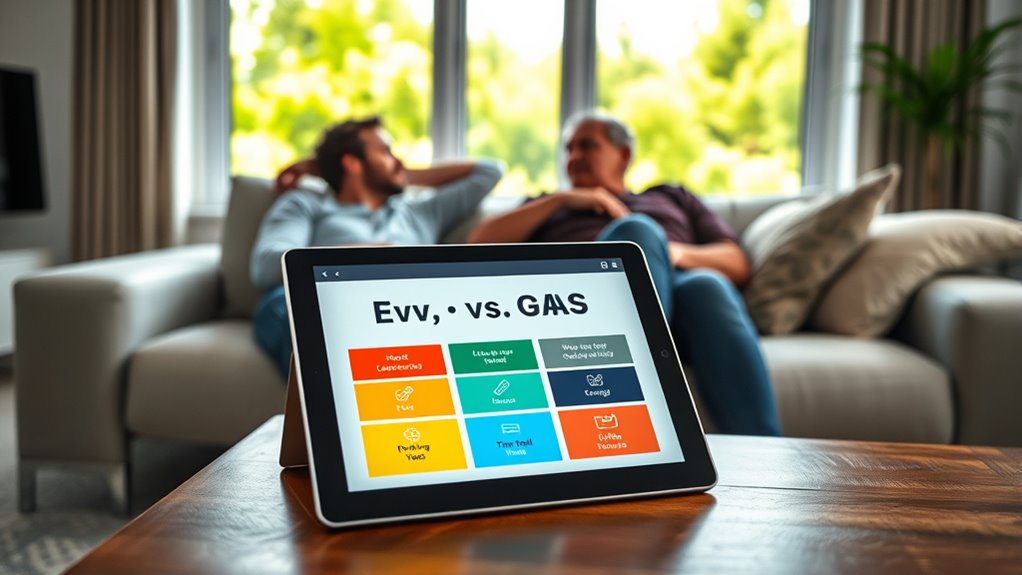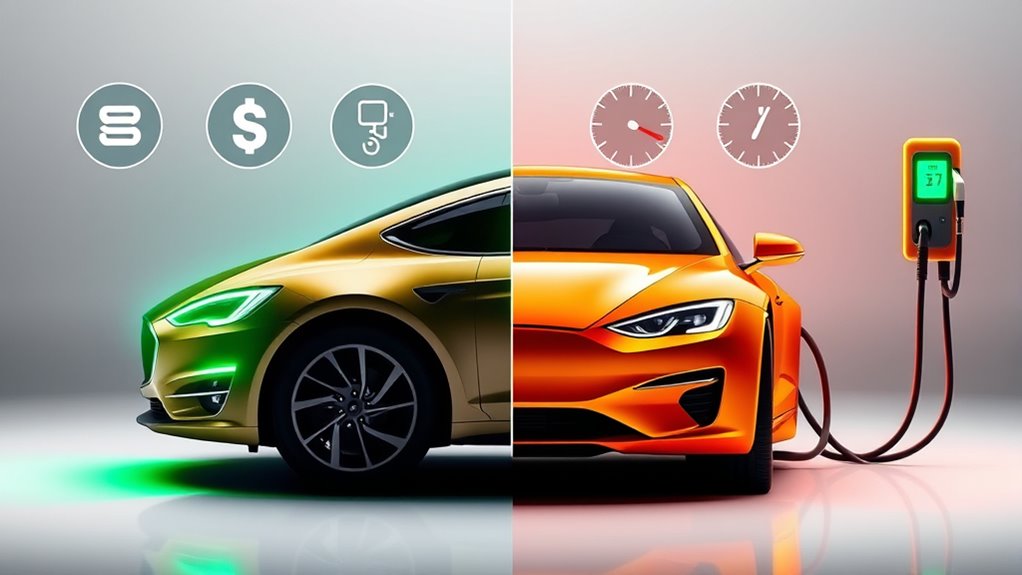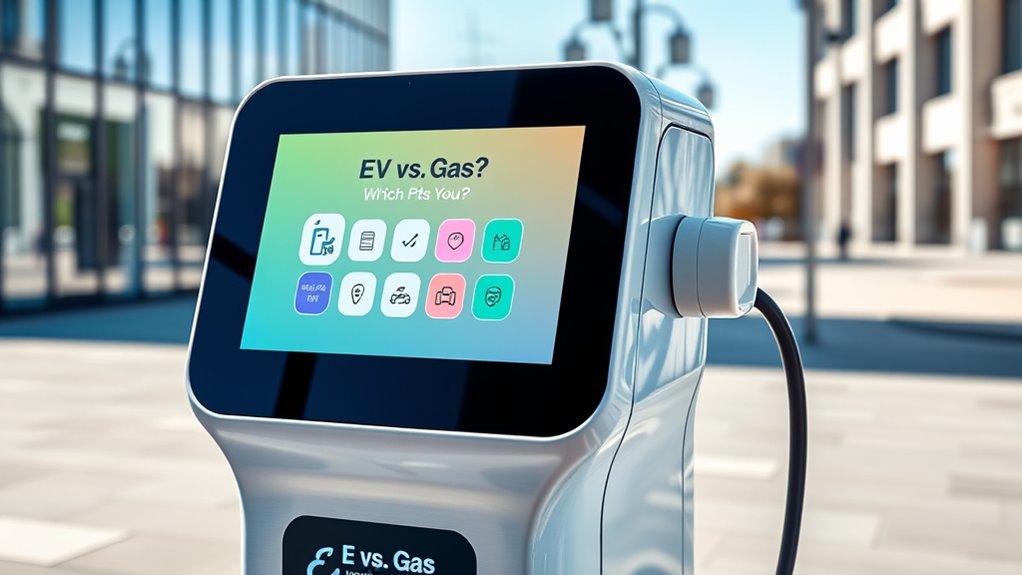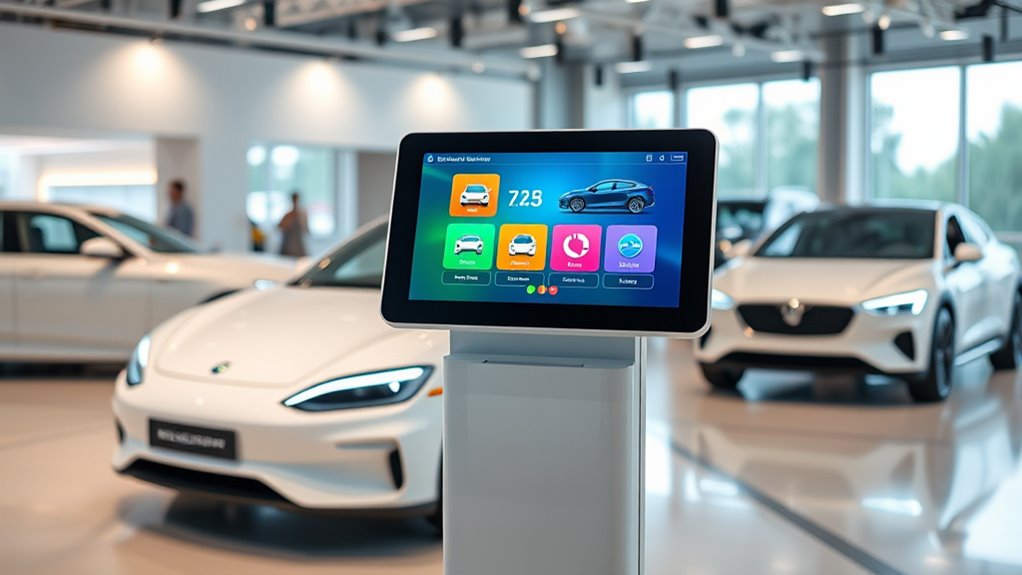To find out which vehicle suits you best, weigh your driving habits, environmental goals, budget, and lifestyle. If you mostly drive short distances and want eco-friendly options, an EV might be right for you. For frequent long trips or quick refills, a gas car could suit better. Considering costs and convenience tips can help make the decision clearer. Keep exploring to discover more ways to match your choice with your lifestyle.
Key Takeaways
- Assess your daily driving distance and local charging options to determine if an EV’s range suits your routine.
- Consider environmental priorities like reducing emissions and using renewable energy sources.
- Evaluate your budget, including upfront costs versus long-term savings on fuel and maintenance.
- Think about convenience factors such as quick fueling, home charging, and travel needs.
- Weigh long-term factors like resale value, safety features, and personal sustainability goals.
Understanding Your Driving Routine

To determine whether an electric vehicle (EV) or a gas-powered car suits you best, start by evaluating your daily driving routine. Consider how often you drive and the distances you cover. If most of your trips are within the range of an EV, it could be a good fit. Also, check the local charging infrastructure—if accessible charging stations are limited, a gas vehicle might be more convenient. Resale value is another factor; currently, gas-powered cars often retain value better, but EV depreciation varies with market trends. Think about your typical driving pattern and infrastructure availability to make an informed choice. Additionally, understanding the range capabilities of different electric vehicles can help you better assess whether an EV meets your daily requirements. Evaluating your driving environment can further clarify which option aligns best with your lifestyle, especially considering home charging options and local electricity costs. Exploring the technological advancements in EV batteries can also provide insight into their future performance and longevity. Moreover, considering your access to public charging stations can influence your overall convenience and satisfaction with an EV.
Assessing Environmental Priorities

Your driving routine provides insight into how an EV or gas vehicle fits your lifestyle, but considering your environmental priorities helps refine that choice. If reducing vehicle emissions is a top concern, an EV powered by renewable energy might be ideal, since it produces zero tailpipe emissions. Alternatively, if minimizing overall environmental impact is key, you may prioritize vehicles with lower emissions and better fuel efficiency. Here’s a quick comparison:
| Environmental Priority | Best Choice |
|---|---|
| Reduce vehicle emissions | Electric vehicle (EV) |
| Use renewable energy | EV charged with renewable sources |
| Minimize carbon footprint | EV with renewable energy |
| Lower fuel consumption | Hybrid or efficient gas vehicle |
| Support clean energy | EV with renewable energy support |
Assessing these priorities helps you make a more eco-conscious decision.
Budget and Cost Considerations

While electric vehicles often have higher upfront costs, they can save you money over time through lower fuel and maintenance expenses, making affordability a key factor in your decision. One important consideration is the battery lifespan; most EV batteries last 8-10 years with proper care, reducing replacement costs. Maintenance costs for EVs tend to be lower because they have fewer moving parts and don’t require oil changes or exhaust system repairs like gas vehicles. Additionally, understanding cost of living adjustments in vehicle expenses can help you plan for future costs and savings. Proper battery maintenance can extend the life of your EV’s power source and maximize your investment. However, initial purchase price can still be a hurdle. Think about your long-term budget—while EVs may seem pricier upfront, savings on fuel and maintenance could offset those costs over the vehicle’s lifespan. Carefully weighing these aspects helps determine which option is more financially sustainable for you.
Convenience and Lifestyle Preferences

Ever wondered how your daily routine aligns with the convenience features of an EV or a gas vehicle? If you often find yourself needing quick refills, a gas car might suit your lifestyle better, thanks to widespread fueling stations. On the other hand, if you prefer home charging, an EV could fit seamlessly into your schedule—especially with expanding charging infrastructure. Consider maintenance requirements too; EVs generally need less upkeep, saving you time and hassle. Additionally, understanding modern design trends in vehicle technology can help you make a more informed choice. Recognizing the importance of reliable sourcing and certification in vehicle components can also reassure you of your vehicle’s quality and safety. Being aware of technological advancements can further influence your decision-making process when choosing between EVs and gas vehicles. However, if you rely on long trips without easy charging options, a gas vehicle provides more flexibility. Your lifestyle, driving patterns, and access to charging stations influence which vehicle aligns best with your convenience preferences.
Making Your Final Choice

Deciding between an EV and a gas vehicle ultimately depends on weighing your priorities and daily habits. If you frequently travel long distances, consider the charging infrastructure in your area—access to fast chargers makes EV ownership more practical. Think about resale value, too; gas vehicles typically have a broader market and established depreciation rates, but EV resale values are improving as demand rises. Reflect on your budget, driving patterns, and environmental goals. If you prioritize lower maintenance and eco-friendliness, an EV might be the better fit. However, if convenience and resale value are critical, a gas car could suit you better. Weigh these factors carefully to make a choice that aligns with your lifestyle and financial plans. Additionally, consider the safety features of electric vehicles, such as advanced driver assistance systems, which can enhance your driving experience and security. Evaluating your overall driving needs and understanding the environmental impact of each option can further guide your decision-making process. Incorporating long-term sustainability considerations can help ensure your choice benefits both your lifestyle and the planet. Moreover, understanding the tuning potential of each vehicle type can inform your decision if performance customization is a priority. You might also explore how ethical hacking principles, such as security assessments, become relevant in the context of connected and smart vehicle technologies.
Frequently Asked Questions
How Do EVS Perform in Extreme Weather Conditions?
Extreme weather can impact EV performance, but battery resilience and thermal management help mitigate issues. Cold temperatures may reduce range, so your EV’s thermal management system keeps the battery at ideal temperature, maintaining efficiency. In hot weather, it prevents overheating and preserves battery health. While climate affects performance, advancements in battery resilience and thermal management make EVs more reliable in extreme conditions, ensuring you stay confident regardless of the weather.
What Are the Long-Term Maintenance Costs for EVS Versus Gas Cars?
Did you know EVs generally have lower long-term maintenance costs? You’ll save on things like oil changes and engine repairs, but you should consider battery longevity, which can impact replacement costs after 8-15 years. Tire wear tends to be similar for both. Overall, EVs offer fewer moving parts, meaning fewer repairs and lower costs over time, making them a smarter investment for the future.
Can I Charge an EV at Home With a Standard Outlet?
You can charge an EV at home using a standard outlet, but it’s slower compared to dedicated chargers. Plugging into a regular 120-volt outlet provides enough power for overnight home charging, making it convenient for daily use. However, if you want faster home charging, installing a dedicated home charging station or Level 2 charger is recommended. This setup increases charging speed and efficiency, saving you time in the long run.
Are There Enough Charging Stations for Long-Distance Travel?
You might wonder if there are enough charging stations for long-distance travel. While the charging infrastructure has improved considerably, it still varies by region. In some areas, you’ll find numerous fast-charging stations, making long trips easier. Regional incentives often support expanding this infrastructure, so check your route beforehand. Planning ahead ensures you won’t run out of power, and you can enjoy your trip with confidence.
How Do Incentives and Rebates Vary by Region?
Regional incentives and rebate variations markedly impact your electric vehicle choices. Depending on where you live, you might find generous rebates or special incentives that reduce your costs, making EVs more affordable. These incentives can vary widely, so it’s essential to check your local policies. By understanding regional incentives, you can maximize savings and make an informed decision that fits your budget and lifestyle.
Conclusion
Now that you’ve explored your driving habits, priorities, and budget, it’s time to make your decision. Whether you choose an EV or a gas car, remember, you’re shaping the future of our planet with every mile. Your choice could be as groundbreaking as a revolution, transforming your daily routine and the environment forever. Trust your instincts, weigh your options, and drive confidently — your perfect fit awaits, ready to revolutionize your journey!









